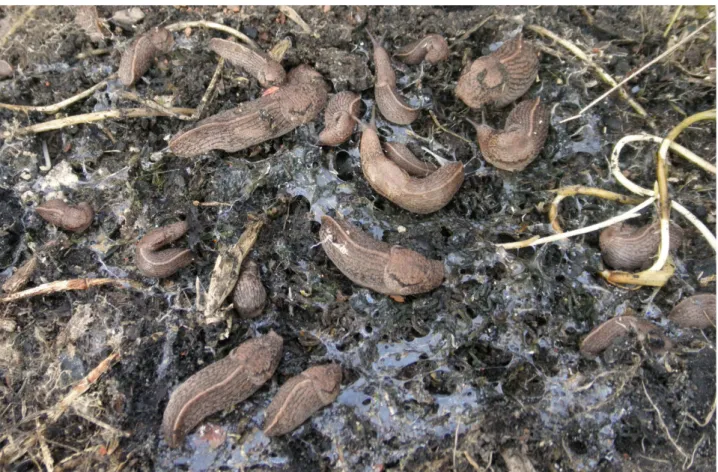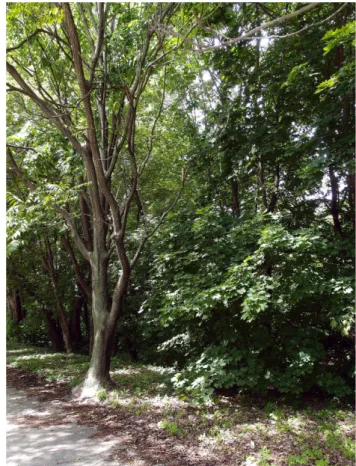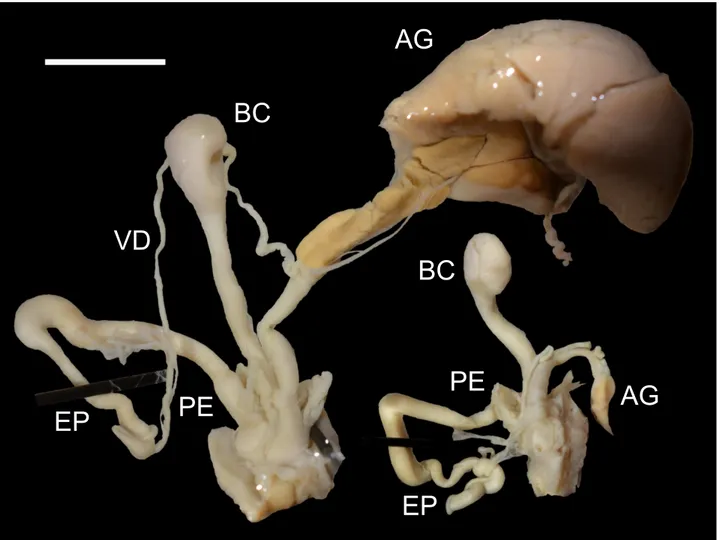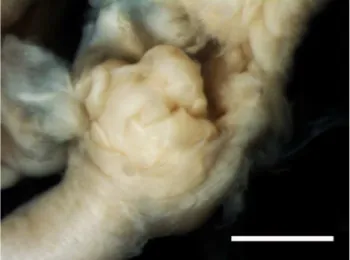Malacologica Bohemoslovaca (2016), 15: –8 ISSN 16-699
Tandonia kusceri
(Pulmonata: Milacidae), a slug new for Slovakia
O
ndřejK
OrábeK1, T
OmášČ
ejKa2& L
uciej
uřiČKOvá1Charles University in Prague, Faculty of Science, Department of Ecology, Viničná 7, CZ-12844 Praha 2, Czech Republic, e-mail: ondrej.korabek@gmail.com (corresponding author)
2Slovak Academy of Sciences, Institute of Botany, Dúbravská cesta 9, SK-845 23 Bratislava, Slovakia, e-mail: t.cejka@gmail.com 3Charles University in Prague, Faculty of Science, Department of Zoology, Viničná 7, CZ-12844 Praha 2, Czech Republic,
e-mail: lucie.jurickova@seznam.cz
KOrábeK O., ČejKa T. & juřiČKOvá L., 2016: Tandonia kusceri (Pulmonata: Milacidae), a slug new for Slovakia. – Malacologica Bohemoslovaca, 15: –8. Online serial at <http://mollusca.sav.sk> 0-June-2016.
Tandonia kusceri (Wagner, 1931) is reported from Slovakia for the irst time. The slug was found in the Ružinov and Petržalka housing estates, Bratislava, in 2014 and 2015, respectively. Our observations suggest that the spe -cies is well established in the Slovak capital. This inding calls for veriication of some of the older reports of a similar species Tandonia rustica beyond the eastern border of its native range. Owing to unresolved taxonomic issues, the name T. kusceri should be applied only tentatively.
Key words: Tandonia rustica, irst record, urban fauna, non-native, introduction
Introduction
Until recently, only two species of the genus Tandonia
Lessona & Pollonera, 1882 had been reported from Slova -kia: Tandonia budapestensis (Hazay, 1881) and Tandonia
rustica (Millet, 1843). The former is a synanthropic spe -cies known so far from just a few records in the south
of the country (HOrsáKet al. 2015), a continuation of its
scattered distribution in Hungary (PinTér & suara 2004).
Tandonia rustica has been reported from three grid squares
in the southwest of Slovakia (LisicKý 1991). These locali
-ties are beyond the eastern limit of the more or less con
-tinuous range of the species, which extends as far east as the Czech Republic (eastern Bohemia) and Austria (Tirol and Upper Austria). The species is absent from Moravia in the south-east of the Czech Republic, leaving a gap be -tween its range and the records from Slovakia and
Hun-gary (reiscHüTz 1986, seidL 1998, HOrsáKet al. 2013).
However, there are a few records attributed to T. rustica
from western Austria (reiscHüTz1986).
In September 2014, we found, together with other partici -pants of the annual meeting of the Czech and Slovak
ma-lacologists, slugs resembling T. rustica in Ružinov, Bratis
-lava (Fig. 1). The slugs were aggregated among the foun
-dations of a long demolished school gym within a housing area built in the 1960s (Fig. 2). At the very same spot a
population of the non-native snail Helix lucorum had been
discovered recently (ČejKa & ČaČaný 2014). Later, we found similar Tandonia slug also among preserved
mate-rial collected in April 2015 in Petržalka housing estate,
Bratislava. It was found there in a small deciduous forest
patch (composed mainly by Acer platanoides and Fraxinus pennsylvanica trees; Fig. 3) by a railway. The housing es
-tate, along with the railway and nearby roads, was built
in the 1970–1980s; aerial photographs from the 1950s
show an athletic stadium at the site. These two sites lie
on the opposite banks of the Danube River and almost
5 km apart.
Tandonia rustica has been reported from Bratislava previ
-ously (POnec 1972, LisicKý 1991); however, the
anthropo-genic habitat of the populations reported here is different from the usual habitat of the species at the eastern limits of its continuous range. In the Czech Republic, T. rustica
mostly lives in broadleaf forests, often on scree slopes,
and in stone accumulations, which is in agreement with
the habitat description provided by WiKTOr (1987). Also,
we have never observed such large aggregations of this species in natural sites (though this behaviour may differ
in other parts of the species range; u. scHnePPaT, personal
communication). For these reasons and because of a slight
-ly different colouration, we suspected that we were dealing
with a different, non-native Tandonia species, most likely with Tandonia kusceri (Wagner, 191). We tested this
as-sumption by comparison with the other Slovak Tandonia
species and a non-native population of T. kusceri from
USA, using dissections and a mitochondrial marker.
Material and methods
We analysed two specimens collected on September 28, 2014, in Ružinov housing estate (Table 1; Fig. 2); see
also ČejKa & ČaČaný (2014) and one individual from the
Petržalka housing estate. The individuals were ixed in ethanol, dissected and identiied following WiKTOr(1987, 1996).
To further demonstrate that the slugs do not belong to any
of the two Tandonia species reported from Slovakia be
-fore, we sequenced a fragment of the mitochondrial 16S rRNA gene from these specimens and from representa
-tives of both Tandonia species reported from Slovakia
already, T. rustica and T. budapestensis (Table 1; samples
4 we also analysed two specimens from another non-native
T. kusceri population from the suburbs of Chicago, USA
(Gerber 2014).
DNA extraction, ampliication and sequencing followed
the same methods as in KOrábeKet al. (2016). The primer
pair Scs1 and Scs2 (cHiba 1999) was used for PCR ampli
-ication of a fragment of the 16S rRNA gene; from the im
-properly preserved individual form Petržalka we eventu
-ally obtained only a shorter fragment (433 bp at the 3’end) using a primer pair by sTeinKe et al. (2004). Unique se
-quences obtained were deposited in GenBank (Table 1). We have also attempted an analysis of the widely used fragment of the gene for cytochrome c oxidase subunit I, for which there are already sequences from Milacidae spe
-cies available in GenBank (rOWsOnet al. 2014). Using the
primer pair LCO1490 and HC02198 (FOLmeret al. 1994),
we initially ampliied and sequenced the COI fragment
from T. rustica and one of the specimens of T. kusceri
from Ružinov. However, these data (GenBank acc. nos. KU641256 and KU641257) were eventually not used any further (see below for explanation).
The 16S sequences were aligned using MAFFT 7 and the
L-INS-i algorithm (KaTOH & sTandLey 2013), and from the alignment pairwise uncorrected genetic distances were calculated after deletion of all columns with gaps or
miss-ing data (Table 2).
Results and discussion
Whereas T. rustica is usually light brown or pinkish, with
a dark pigmentation on the body posterior to the mantle
aggregated into distinct spots, the dark pattern of the spec-imens from Bratislava was much more diffuse (Fig. 1), as it is usual for T. kusceri (WiKTOr 1996). The length of the
epiphallus and vas deferens relative to the penis, the shape
of the transition between them and the shape of the penial
Fig. 1. Aggregation of Tandonia kusceri (Wagner, 1931) in Bratislava – Ružinov, 2014, September 28. Photo by M. Maňas.
Table 1. Sampling localities and GenBank accession numbers. Vouchers of T. rustica and T. kusceri from Bratislava are deposited in the private collection of O. Korábek, specimens from USA are deposited in the Field Museum of Natural History, Chicago, USA, #328572.1 and #328572.4. Where the obtained sequences were identical, only one representative has been submitted to GenBank; for details refer to the Materials and Methods section.
species locality GPS coordinates GenBank accession numbers
T. kusceri Slovakia: Bratislava, Ružinov, Borodáčova Street 48.1536°N, 17.1726°E KU234273 (16S), KU641257 (COI) T. kusceri Slovakia: Bratislava, Petržalka, Černyševského
Street
48.1302°N, 17.1186°E
T. kusceri USA: Illinois: suburbs of Chicago, Cook County,
Brookield, Jefferson Avenue 41.8283°N, −87.8564°E KU234274 (16S) T. rustica Czech Republic: Roztoky, U Eremita 50.0154°N, 13.8589°E KU234275 (16S),
papilla conformed to the description of T. kusceri provided
by WiKTOr (1996) (Figs. 4, 5). The bursa copulatrix was
not pointed and the epiphallus was coiled, as it should be
in T. kusceri.
The 16S sequences obtained from the Slovak samples were identical. The T. kusceri from Chicago, Illinois, USA, dif
-fered from Slovak samples in only three positions, while
the T. rustica sample differed by 17% from all T. kusceri
samples (Table 2). Although high, this value is still with
-in the range occasionally observed with-in slug species
(PinceeLet al. 2005).
In the COI locus T. kusceri sample from Ružinov dif -fered from T. rustica (our sample and GenBank acc. no.
KF894265; rOWsOn et al. 2014) by 14%. However, the
COI sequences from T. kusceri and T. rustica were
high-ly divergent from the available sequences of other Mi -lacidae species (Milax gagates, Tandonia sowerbyi, and
T. budapestensis; rOWsOnet al. 2014). Unlike for the other
Milacidae, BLAST searches against the GenBank nucle
-otide database (performed May 2, 2016) resulted in best hits outside Milacidae (within Vertiginidae) for T. kusceri
and T. rustica. One may wonder whether one of these two
groups of milacid COI sequences represents pseudogene sequences or, probably more likely, they just relect a deep
divergence in mitochondrial genes within Milacidae and
possibly non-monophyly of Tandonia in respect of Milax.
There were no stop codons in our sequences or in the data
from rOWsOnet al. (2014) either; translated to amino acid
sequences, T. rustica and T. kusceri differ from the other
Milacidae in a few chemically dissimilar amino acids (e.g. threonine vs. lysine), but these amino acids can be found at homologous positions in some other European slug families. Due to the lack of 16S data from other Milacidae
and related families we could not have tested the
alterna-tive explanations, but we decided not to use COI further just to be sure.
Based on the internal morphology, the habitat and the mo -lecular data we conclude that the population from
Bratis-lava belongs not to T. rustica, but to T. kusceri. This is the irst record of T. kusceri in Central Europe. The species has been described from the environs of Niš, Serbia, and its reported range includes Dobrogea in Romania, Bulgar
-ia, European Turkey, Serb-ia, Macedon-ia, Montenegro, and
Croatia (WiKTOr 1987, 1996, WiKTOr & jurKOvsKa 2007,
Fig. 2. The locality of T. kusceri in Bratislava – Ružinov; Sep -tember 2014. The slugs were found under bricks and pieces of concrete. Photo by M. Maňas.
Fig. 3. The locality of T. kusceri in Bratislava – Petržalka; June
2016. Photo by T. Čejka.
Table 2. Uncorrected genetic distances (p-distances) between the 16S fragments of the analysed samples.
T. kusceri (SK) T. kusceri (US) T. rustica (CZ) T. budapestensis (CZ)
T. kusceri (SK)
-T. kusceri (US) 0
-T. rustica (CZ) 0.17 0.17
-VD
BC
PE
PE
EP
AG
EP
AG
BC
Fig. 4. The genital systems of T. kusceri individuals from Bratislava – Ružinov; scale bar 5 mm. AG – albumen gland; BC – bursa
copulatrix; EP – epiphallus; PE – penis. Photo by O. Korábek.
TeLebaKet al. 201). Tandonia kusceri often lives synan
-thropically and is commonly found in habitats similar to
the sites in Bratislava (WiKTOr1987). Isolated populations of T. kusceri have been reported from the Ukraine (sOn
2004, LeOnOv 2007), Moldova (baLasHOvet al. 2013) and
the USA (Gerber 2014).
Presence of individuals of different sizes at the Ružinov site in 2014 (Fig. 1) already indicated that the T. kusceri
population was successfully reproducing. In June 2016 Tomáš Čejka counted there 83 individuals within half an hour, proving that the population successfully overwin
-ters and reproduces. Population at Petržalka site was less numerous, only seven individuals were found during the half an hour of individual searching. Although we have not found any other T. kusceri populations in an immediate
vicinity of the Ružinov site, the second record from a rath
-er distant site in Petržalka suggests that the species may be already well established in the Slovak capital. Slugs identiied then as T. rustica had been found in Slovakia for the irst time between 1965 and 1967 in vineyards in the northern suburbs of Bratislava (POnec1972). LisicKý
(1991) added a further record from Bratislava and another
one from the Czech-Slovak border near Skalica or Holíč. Only POnec (1972) igured a specimen from the reported
locality, and the coloration differed from the slugs reported here by having rather distinct dark spots, as is usual in
T. rustica, but a reliable identiication would be possible
only based on characters on genitalia. No voucher speci -mens of “T. rustica” are preserved in the collections of M.
Lisický (Bratislava), and we are not aware of any extant vouchers from Ponec’s research. It is possible that at least some of these records actually refer to T. kusceri, which
presence in Slovakia may thus already last several dec -ades.
There might be some more non-native occurrences of
T. kusceri in the literature hidden behind the name T.
rus-tica from adjacent countries. PinTér & suara (2004) listed
two occurrences of T. rustica in Hungary, in the urban area
of Esztergom (north of the country) and at an unspeciied site in the Kőszeg County (northwestern Hungary). reis
-cHüTz (1986) reported T. rustica from Burgenland (eastern
Austria, actually near Kőszeg) and from Vienna and its vi
-cinity. We suggest that the species identity of these T.
rus-tica populations beyond its range limits should be revised,
especially when they originate from urban habitats.
However, the name T. kusceri for the non-native Slovak
slugs should be used with caution. The genus has the cen
-tre of diversity in the Balkans, and taxonomy of the spe -cies living there is far from resolved. WiKTOr (1987) sug-gested that Tandonia serbica (Wagner, 1930), described
from the same type locality as T. kusceri, might represent just a different stage of development or genital morph of
the latter. If synonymous, the name T. serbica would have
Fig. 5. Penial papilla of T. kusceri from Bratislava – Ružinov; scale bar 1 mm. Photo by O. Korábek.
The presented inding is just another one in a row of south-European species discovered in the capitals of the
region (e.g. PinTér & suara 2004, FiscHer et al. 2008,
PeLTanOvá et al. 2012, duda & mrKvicKa 2014). Large
cities are transport hubs and centres of trade and the new alien gastropod species have been most likely introduced as contaminants with goods. Thus the concentration of new records in the capitals may be real and not only an artefact of better sampling. Nevertheless, as long as the introduced species remain restricted to the urban habitats, their signif
-icance for the regional biota is limited. Milacid slugs seem to be able to colonize new territories quite successfully. Some other species of the family (Milax gagates,
Tando-nia sowerbyi, T. budapestensis and others; e.g. reiseet al. 2006; WeLTer-scHuLTes 2012; HuTcHinsOn & reise 201;
rOWsOnet al. 2014) already have considerable secondary
ranges and some are pests. Only time will tell whether
T. kusceri will be able to spread across Central Europe.
Ackowledgements
We thank Jochen Gerber (Field Museum of Natural His
-tory, Chicago) for samples of T. kusceri from the USA, Michal Maňas for photos, and Juraj Čačaný for help with the historic Slovak records. Adam Petrusek and Heike Reise provided valuable comments on an earlier version of the manuscript. The work was supported by the Grant Agency of the Charles University in Prague (GAUK
project no. 615).
References
baLasHOv i. a., sOn m. O., cOadă v. & WeLTer-scHuLTes F.,
2013: An updated annotated checklist of the molluscs of the Republic of Moldova. – Folia Malacologica, 21: 175–181.
ČejKa T. & ČaČaný j., 2014: The irst record of the Turkish snail (Helix lucorum L., 1758) in the Slovak Republic. – Malaco -logica Bohemoslovaca, 13: 124–125.
cHiba s., 1999: Accelerated evolution of land snails Mandarina in the oceanic Bonin Islands: evidence from mitochondrial DNA sequences. – Evolution, 53: 460–471.
duda m. & mrKvicKa a., 2014: Zur Ausbreitung der Neozoen Monacha cantiana (MONTAGU 1803), Hygromia cinctella
(DRAPARNAUD 1801), Cepaea nemoralis (LINNÉ 1758) und Cornu aspersum (O. F. MÜLLER 1774) im südwestlichen
Umland von Wien. – Nachrichtenblatt der Ersten Vorarlberger Malakologischen Gesellschaft, 21: 11–13.
FiscHer W., nOvaK j. & reineLT K., 2008: Beiträge zur Kenntnis der österreichischen Molluskenfaua XIII. Zum Vorkommen von
Helix lucorum LINNE 1758, Cernuella neglecta
(DRAPAR-NAUD 1805) und Cernuella virgata (DA COSTA 1758) in
Wien (Gastropoda: Mollusca). – Nachrichtenblatt der Ersten Vorarlberger Malakologischen Gesellschaft, 15: 63–64.
FOLmer O., bLacK m., HOeH W., LuTz r. & vrijenHOeK r., 1994:
DNA primers for ampliication of mitochondrial cytochrome c oxidase subunit I from diverse metazoan invertebrates. – Mo -lecular Marine Biology and Biotechnology, 3: 294–299.
Gerber j., 2014: First American record of the exotic slug Tan
-donia kusceri (Gastropoda: Milacidae). – The Nautilus, 128: 59–6.
HOrsáK m., juřiČKOvá L. & PicKa j., 2013: Měkkýši České a
Slovenské republiky. Molluscs of the Czech and Slovak Repub -lics. – Nakladatelství Kabourek, Zlín, 264 pp.
HOrsáK m., ČejKa T., juřiČKOvá L., beran L., HOráČKOvá j., HLaváČ j. Č., dvOřáK L., HájeK O., maňas m. & LOžeK v.,
2015: Check-list and distribution maps of the molluscs of the Czech and Slovak Republics. – Online at http://mollusca.sav. sk/malacology/checklist.htm, accessed November 25, 2015.
KaTOH K. & sTandLey d. m., 2013: MAFFT multiple sequence alignment software version 7: improvements in performance and usability. – Molecular Biology and Evolution, 30: 772– 780.
KOrábeK O., juřiČKOvá L. & PeTruseK a., 2016: Splitting the Roman snail Helix pomatia Linnaeus, 1758 (Stylommatophora: Helicidae) into two: redescription of the forgotten Helix thes -salica Boettger, 1886. – Journal of Molluscan Studies, 82: 11–22.
LeOnOv s. v., 2007: The irst record of the Tandonia kusceri
(Pulmonata, Milacidae) in Crimea and a few remarks about its natural habitats. – Vestnik Zoologii, 41(2): 142.
LisicKý m. j., 1991: Mollusca Slovenska. [Mollusca of Slova-kia]. – Veda, Bratislava, 344 pp.
PeLTanOvá a., PeTruseK a., KmenT P. & juřiČKOvá L., 2012: A fast snail’s pace: colonization of Central Europe by Mediter -ranean gastropods. – Biological Invasions, 14: 759–764.
PinceeL j., jOrdaens K. & bacKeLjau T., 2005: Extreme mtDNA
divergences in a terrestrial slug (Gastropoda, Pulmonata, Arionidae): accelerated evolution, allopatric divergence and secondary contact. – Journal of Evolutionary Biology, 18: 1264–1280.
PinTér L. & suara r., 2004: Magyarországi puhatestüek kata -lógusa hazai malakológusok gyüjtései alapján. [Catalogue of the Hungarian molluscs based on the collectings of Hungarian malacologists]. – Magyar Természettudományi Múzeum, Budapest, 574 pp.
POnec j., 1972: Mollusca Malých Karpát. [Mollusca of the Malé
Karpaty Mts.]. – Acta Rerum Naturalium Musei Nationalis Slo -vaci, 18: 71–114.
reiscHüTz P. L., 1986: Die Verbreitung der Nacktschnecken Ös -terreichs (Arionidae, Milacidae, Limacidae, Agriolimacidae, Boettgerillidae). – Sitzungsberichte der Akademie der Wissen -schaften, mathematisch-naturwissenschaftliche Klasse, 195: 67–190.
reise H., HuTcHinsOn j. m. c. & rObinsOn d. G., 2006: Two in -troduced pest slugs: Tandonia budapestensis new to the Amer -icas, and Deroceras panormitanum new to the eastern USA.
– The Veliger, 48: 110–115.
rOWsOn b., andersOn r., Turner j. a. & symOndsOn W. O.,
2014: The slugs of Britain and Ireland: undetected and unde -scribed species increase a well-studied, economically important fauna by more than 20%. – PLoS ONE, 9: e91907.
(RAZOUMOWSKY 1789) und Tandonia rustica (MILLET 1843) in der Umgebung von Braunau am lnn, Oberösterreich. – Mitteilungen der Zoologischen Gesellschaft Braunau, 7(2): 125–11.
sOn m. O., 2004: New record of Tandonia kusceri (Pulmonata, Milacidae) in Ukraine – Vestnik Zoologii, 38: 76.
sTeinKe d., aLbrecHT c. & PFenninGer m., 2004: Molecular
phylogeny and character evolution in the Western Palaearctic Helicidae s.l. (Gastropoda: Stylommatophora). – Molecular Phylogenetics and Evolution, 32: 724–734.
TeLebaK b., brajKOvić m. & ćurČić s., 2013: Contribution to
the knowledge of the slugs (Gastropoda: Stylommatophora: Limacidae and Milacidea) from Montenegro. – Bulletin of the
Natural History Museum in Belgrade, 6: 55–64.
WeLTer-scHuLTes F., 2012: European non-marine molluscs,
a guide for species identiication. – Planet Poster Editions, Göt -tingen, 679 pp.
WiKTOr a., 1987: Milacidae (Gastropoda, Pulmonata) – system -atic monograph. – Annales Zoologici, 41: 153–319.
WiKTOr a., 1996: The slugs of the former Yugoslavia (Gastro -poda terrestrial nuda – Arionidae, Milacidae, Limacidae, Agri -olimacidae). – Annales Zoologici, 46: 1–110.
WiKTOr a. & jurKOWsKa j., 2007: The collection of terrestrial



